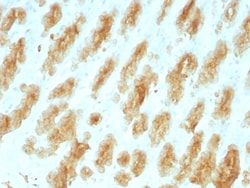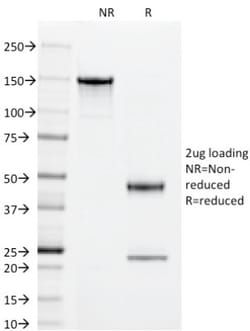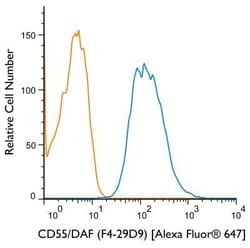Cytokeratin, LMW Antibody (KRTL/1077), Novus Biologicals™
Mouse Monoclonal Antibody
Manufacturer: Fischer Scientific
The price for this product is unavailable. Please request a quote
Antigen
Cytokeratin, LMW
Concentration
0.2mg/mL
Applications
Western Blot, Flow Cytometry, Immunohistochemistry (Paraffin), Immunofluorescence
Conjugate
Unconjugated
Host Species
Mouse
Target Species
Human, Rat
Gene Accession No.
Q7Z794
Gene ID (Entrez)
374454
Immunogen
Recombinant human KRT77 protein
Primary or Secondary
Primary
Content And Storage
Store at 4C.
Clone
KRTL/1077
Dilution
Western Blot 0.5 - 1.0 ug/ml, Flow Cytometry 0.5 - 1 ug/million cells in 0.1 ml, Immunohistochemistry-Paraffin 0.5 - 1.0 ug/ml, Immunofluorescence 1 - 2 ug/ml
Classification
Monoclonal
Form
Purified
Regulatory Status
RUO
Formulation
10mM PBS and 0.05% BSA with 0.05% Sodium Azide
Gene Alias
Cytokeratin LMW, cytokeratin-1B, keratin 77, keratin, type II cytoskeletal 1b, KRT77, type-II keratin Kb39
Gene Symbols
KRT77
Isotype
IgG1 κ
Purification Method
Protein A or G purified
Test Specificity
This MAb recognizes the 56.5kDa (CK10); 50kDa (CK14); 50kDa (CK15); 48kDa (CK16); 40kDa (CK19) keratins of the acidic (Type I or LMW) subfamily. Twenty human keratins are resolved with two-dimensional gel electrophoresis into acidic (pI 6.0) subfamilies. The acidic keratins have molecular weights (MW) of 56.5, 55, 51, 50, 50, 48, 46, 45, and 40kDa. Many studies have shown the usefulness of keratins as markers in cancer research and tumor diagnosis.
Description
- Ensure accurate, reproducible results in Western Blot, Flow Cytometry, Immunohistochemistry (Paraffin), Immunofluorescence Cytokeratin, LMW Monoclonal specifically detects Cytokeratin, LMW in Human, Rat samples
- It is validated for Immunohistochemistry, Immunohistochemistry-Paraffin.



